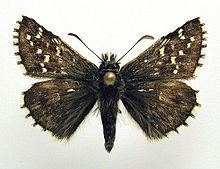Family Hesperiidae Scientific name Pyrgus andromedae | Genus Pyrgus Rank Species | |
 | ||
Similar Dusky grizzled skipper, Large grizzled skipper, Rosy grizzled skipper, Carline skipper, Olive skipper | ||
How to say alpine grizzled skipper in german
The Alpine grizzled skipper (Pyrgus andromedae) is a species of skipper (family Hesperiidae). This species is found up to fairly high altitudes in the Alps and Pyrenees and also at lower elevations in northern Scandinavia, where its range extends well into the Arctic Circle. It prefers damp habitats and is often found near to water.
Contents
- How to say alpine grizzled skipper in german
- Description
- Distribution and habitat
- Life cycle
- Status
- References
Description
This is a medium-sized Pyrgus skipper with a wingspan of 26–30 mm. The dark brown forewing is marked with a bold pattern of white spots; by contrast the hindwing is plain dark brown with little or no patterning. The underside of the hindwing has two distinctive pale markings close to the dorsum: an elongated streak and a round spot, often likened to an exclamation mark (!). The adult flies in June and July. It has a rapid flight, low over the ground.
Distribution and habitat
The Alpine grizzled skipper is found at high altitudes in Europe. It is known from the Pyrenees, where it is rare, the Alps, the Carpathians, southwest Bosnia, southwest Serbia, northwest Macedonia, Lapland and the border between Norway and Sweden. In the Swiss Alps its height range is 1,000 to 2,700 metres (3,300 to 8,900 ft) and in the Pyrenees 1,500 to 2,000 metres (4,900 to 6,600 ft). In the Alps and Pyrenees, its natural habitat is above the tree line in damp, grassy places, often near streams or in bogs. In its Scandinavian range it occurs in areas with dwarf scrubby vegetation and on steep slopes and in rocky areas.
Life cycle
There is just one generation per year. The eggs are laid individually. The larvae have been recorded on Alchemilla glomerulans, Alpine lady's mantle (Alchemilla alpina), mountain avens (Dryas octopetala) and several species of cinqefoils (Potentilla). The caterpillars spin a silken web and anchor leaves together to make a shelter in which they congregate. They hibernate over winter and pupate in a similar shelter the following spring.
Status
Although some populations of Alpine grizzled skipper are in decline (especially in Austria) the IUCN lists the species as being of "least concern" as there are no identifiable threats to it at a continent-wide level.
